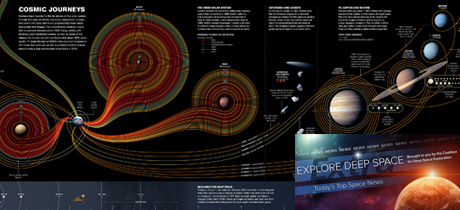In Today’s Deep Space Extra… NASA’s proposed lunar orbiting Deep Space Gateway (DSG) to be featured in the latest version of an evolving, multinational human and robotic exploration road map.
Human Space Exploration
Deep Space Gateway (DSG) key part of updated exploration roadmap
Space News (11/30): NASA’s Deep Space Gateway (DSG), a proposed human tended lunar orbiting outpost, figures to find a place in the third and latest edition of the Global Exploration Roadmap, an evolving blueprint for human exploration beyond low Earth orbit. The road map is a cooperative but non-binding effort by the International Space Exploration Coordination Group, a collection of 14 nations, including the U.S., Australia, Canada, China, European nations, India, Japan, Russia and Ukraine, organized to present and discuss opportunities for multi-national cooperation. The third version of the road map is to be released in early 2018. The DSG would serve as a space depot for future human and robotic missions to the lunar surface, asteroids and Mars.
NASA launches new phase of 3-D habitat challenge with $2 million prize
Space.com (11/30): The deadline is February 15 for competitors to register for a multi-million dollar NASA prize for suggestions on how to develop human space exploration assets using resources found in space. One need is a human shelter for the lunar and Martian surfaces that could be robotically constructed from the natural resources found on the two planetary bodies.
MAF simulating SLS engine installation with RS-25 pathfinder
NASAspaceflight.com (11/30): MAF is NASA’s Michoud Assembly Facility outside of New Orleans and the site where the agency assembles the core stage of the Space Launch System (SLS) and Orion crew capsule, both cornerstones of U.S. plans to resume human deep space exploration. Workers at Michoud are rehearsing the equipping of the SLS first stage with four RS-25 rocket engines.
Space Science
That ‘alien’ bacteria on the Space Station? It’s probably not aliens.
Mashable (11/30): Bacteria discovered by spacewalking cosmonauts on the exterior of the International Space Station and identified earlier this week as “alien” are more likely from terrestrial contamination on space station modules before they were launched from Earth, according to astrobiologists.
Mega-landslides on Mars may speed down slopes at 450 mph
Space.com (11/30): Italian researchers find evidence for massive, high velocity landslides on the Martian terrain, likely accelerated by the presence of ice. The findings are published in the European Physical Journal Plus.
New telescope sees galaxy down to its atoms
Sky and Telescope (11/30): The Australian Square Kilometer Array Pathfinder radio telescope has captured a close-up look at the neighboring Small Magellanic Galaxy, which is 200,000 light years from the Earth. The survey offers a detailed picture of the hydrogen gas. Hydrogen atoms are the building blocks for future stars.
Other News
ESA pours $107 million into Vega E and a reusable spaceplane
Space News (11/30): The European Space Agency has approved $106.7 million in expenditures for upgrades to its Vega launch vehicle and future development of the Space Rider, a reusable, unmanned space plane that is to place payloads in low Earth orbit for up to two months and return to Earth with a landing on the ground.
Lompoc Record (11/30): The commander of Vandenberg Air Force Base, California, calls for more investment in infrastructure and personnel to meet the needs of the nation’s commercial launch industry.

